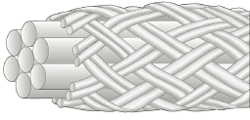|
|

Thin Is In

The improved "packing density" of the Zyex core designed by Ashaway yielded the thinnest strings yet, while "packing" in more Zyex filaments per cross-section (for better strength) than ever before-a perfect blend for hard-hitting racquetball enthusiasts who are not willing to give up power. |
By Steve Crandall
Vice President, Sales & Marketing
Ashaway Racket Strings
Every player has his or her own unique style and preferences-and sporting goods manufacturers understand that. That's why we generally offer a spectrum of choices and try not to push our personal preferences.
Thus, as many of you know, I have, for the most part, held to a neutral party line regarding the thick string vs. thin string controversy. When asked, I have been known, very diplomatically, to explain that thin strings provide more trampoline power and deeper ball penetration, and offer lower wind resistance and weight-while thick strings offer greater directional control, stiffness and durability. Then I leave it to the player to weigh their stringing goals and take their pick.
Well, a new day has dawned on this topic, and today I say, "Thin is in!" Here's why.
Core Issue
Until fairly recently, nylon strings-at relatively thicker sizes (up to 1.40 mm)-accounted for the majority of racquetball strings in use. New string manufacturing technologies over the past decade and a half, however, have given rise to an evolution toward thinner string, creating the
17-gauge super-strings of today that measure in at 1.25 mm. One of the reasons for this is that, about 15 years ago, a new high temperature, engineering grade polymer known as PEEK (polyetheretherketone for short!) entered the marketplace.
Marketed as Zyex®, this material offered resilient, yet compact fibers that allowed for the manufacture of thin and energetic cores for racquetball racket strings. Unfortunately, the early manufacturing process for Zyex was difficult to control, resulting in fibers with inconsistent thickness and strength. It was possible to make a good string from this material, but not a great one.
However, technological advances over the past few years have resulted in vast improvements in the quality of Zyex. Further, the development of new design and manufacturing techniques has allowed string makers to take full advantage of this material's unique properties. Ashaway, for example, has developed a multi fiber process to manufacture second generation Zyex racket string cores for our PowerKill® line of strings. The improved "packing density" of the Ashaway designed Zyex core has yielded the thinnest strings yet, while "packing" in more Zyex filaments per cross-section (for better strength) than ever before-a perfect blend for hard-hitting racquetball enthusiasts who are not willing to give up power.
Here's a look at some of the benefits these super-thin Zyex strings provide:
"Dynamic Stiffness." The best scientific measure of playability is called "dynamic stiffness," and low dynamic stiffness equals better playability. Low dynamic stiffness means the strings continue to stretch throughout more of the stroke, forming a pocket around the ball-instead of flattening it. This equals more power, as the ball is catapulted off the strings. Zyex strings feature extremely low dynamic stiffness when compared to other string materials, such as nylon.
More Bite. Because the super-thin strings present less surface area, they bite into the ball better, making it easier to re-create your signature shot. This bite results in more control over spin and direction.
Minimal Tension Loss. When nylon is strung on a racket, it loses up to a quarter of its original stringing tension before the player makes it onto the court. Zyex does not lose tension as quickly. This means that Zyex should be strung at 10-15% less initial tension than nylon to achieve the desired result at playing time. But the best part is that, after some initial tension loss, the Zyex string will maintain its tension for years. As time goes by, players will have to make few, if any, adjustments in their playing style to accommodate changing string tension in their frame.
Weatherability. Heat and moisture are enemies of racket string. Amazingly, high humidity (and temperatures between 60° - 300°F) have virtually no effect on Zyex strings. For an indoor sport like racquetball, this may not seem like a big advantage. However, anyone who has stored their racket in the trunk of their car on a hot, humid day, or in a damp basement during the off-season, will appreciate this quality immensely.
Thicker racquetball racket strings aren't going away anytime soon. Some players simply prefer the way they play and feel. But, lower weight and wind resistance, maximal tension holding, minimal weathering, better bite, power and playability tip the scales, for me at least, in favor of the right thin string.
I have one more interesting tidbit to add: not only do Zyex strings offer greater durability in a thinner package, they also sound better than other string materials. No joke. High-end instrument manufacturers use the material for strings on violins and violas. In fact, if we did not add a sound-dampening step into the manufacturing process, some of us would be making more lively music on the racquetball court as well.
ZYEX® is a registered trademark of Victrex Ltd.
This article previously appeared in Racquetball Magazine.
|